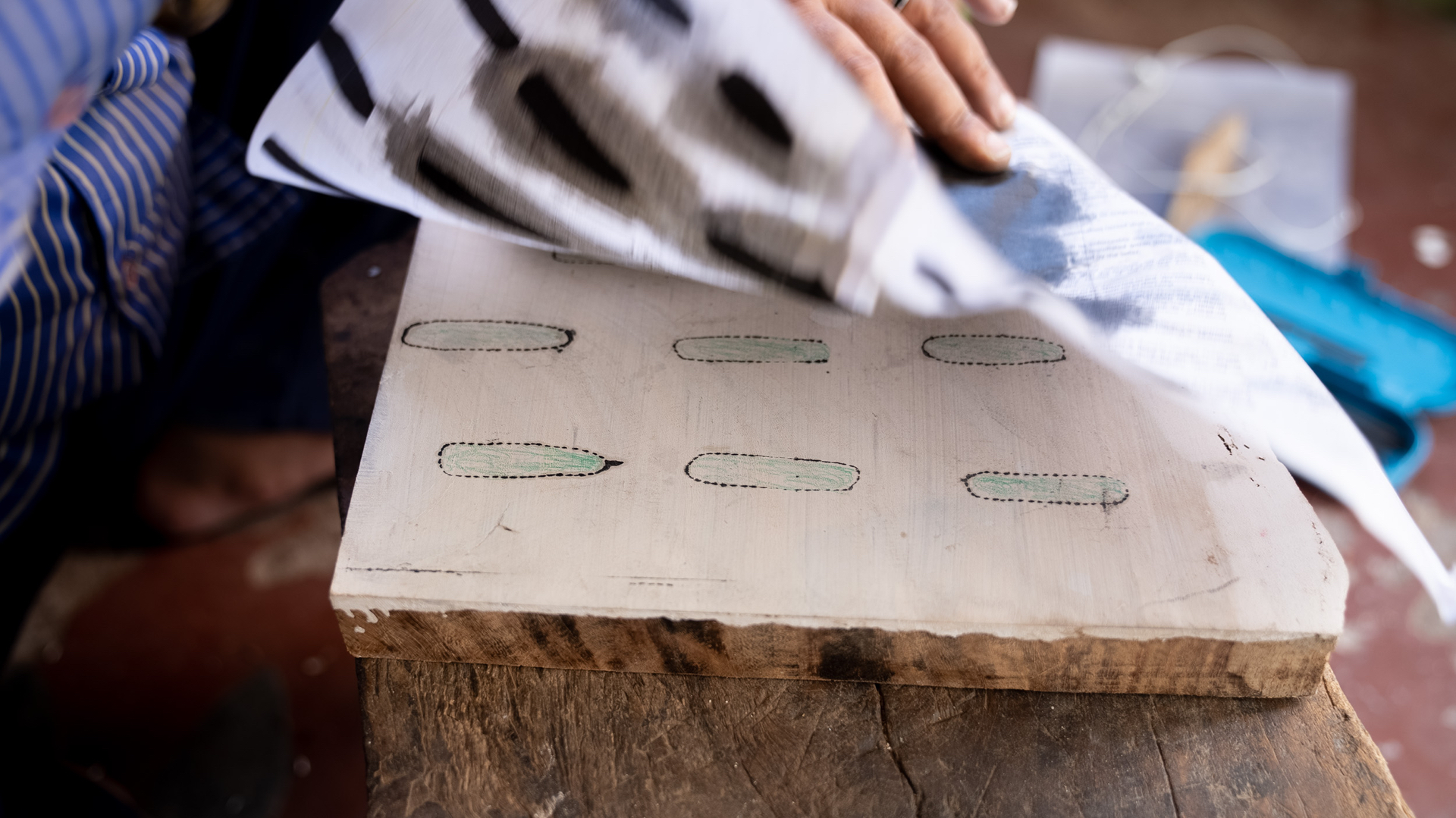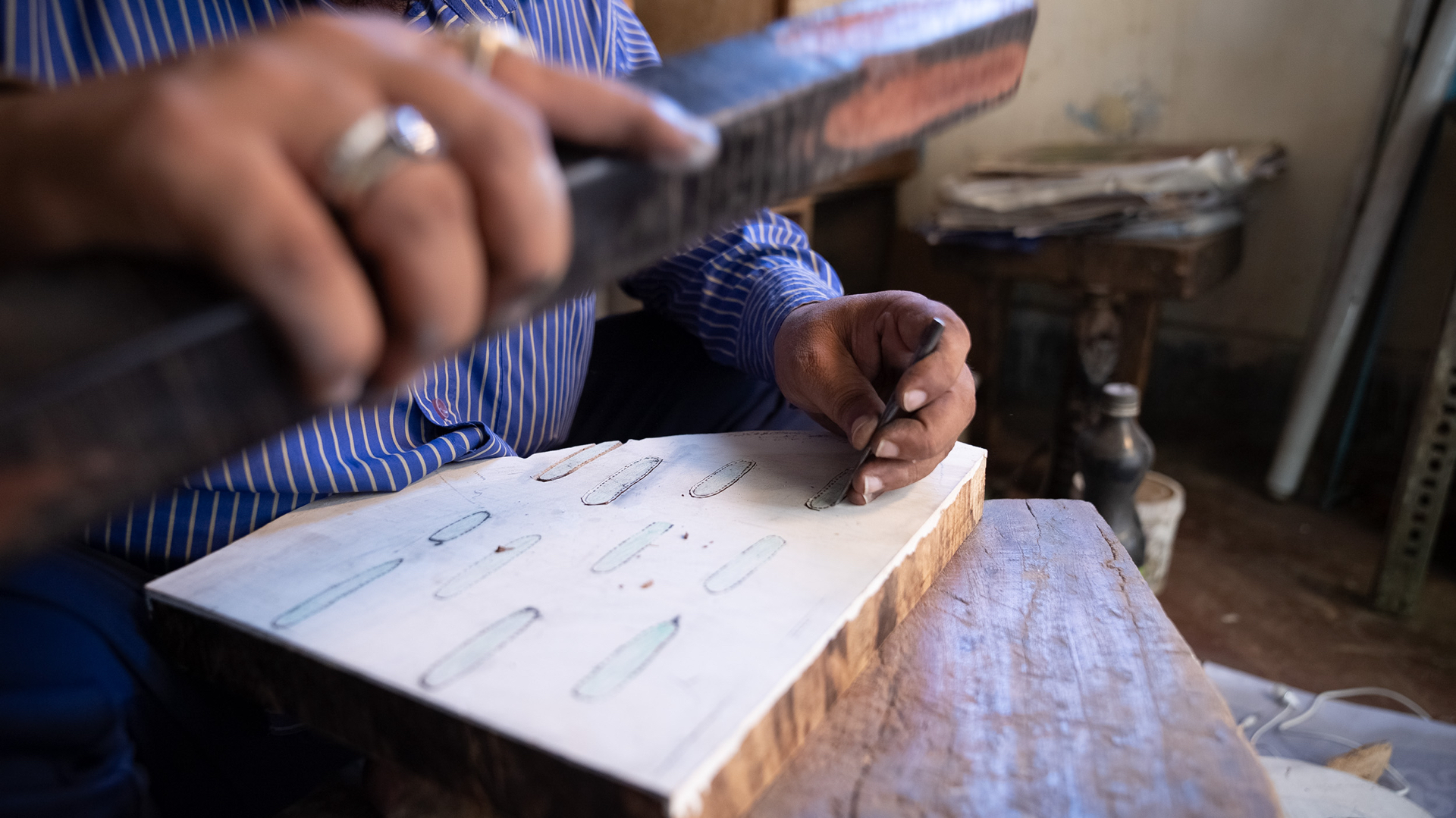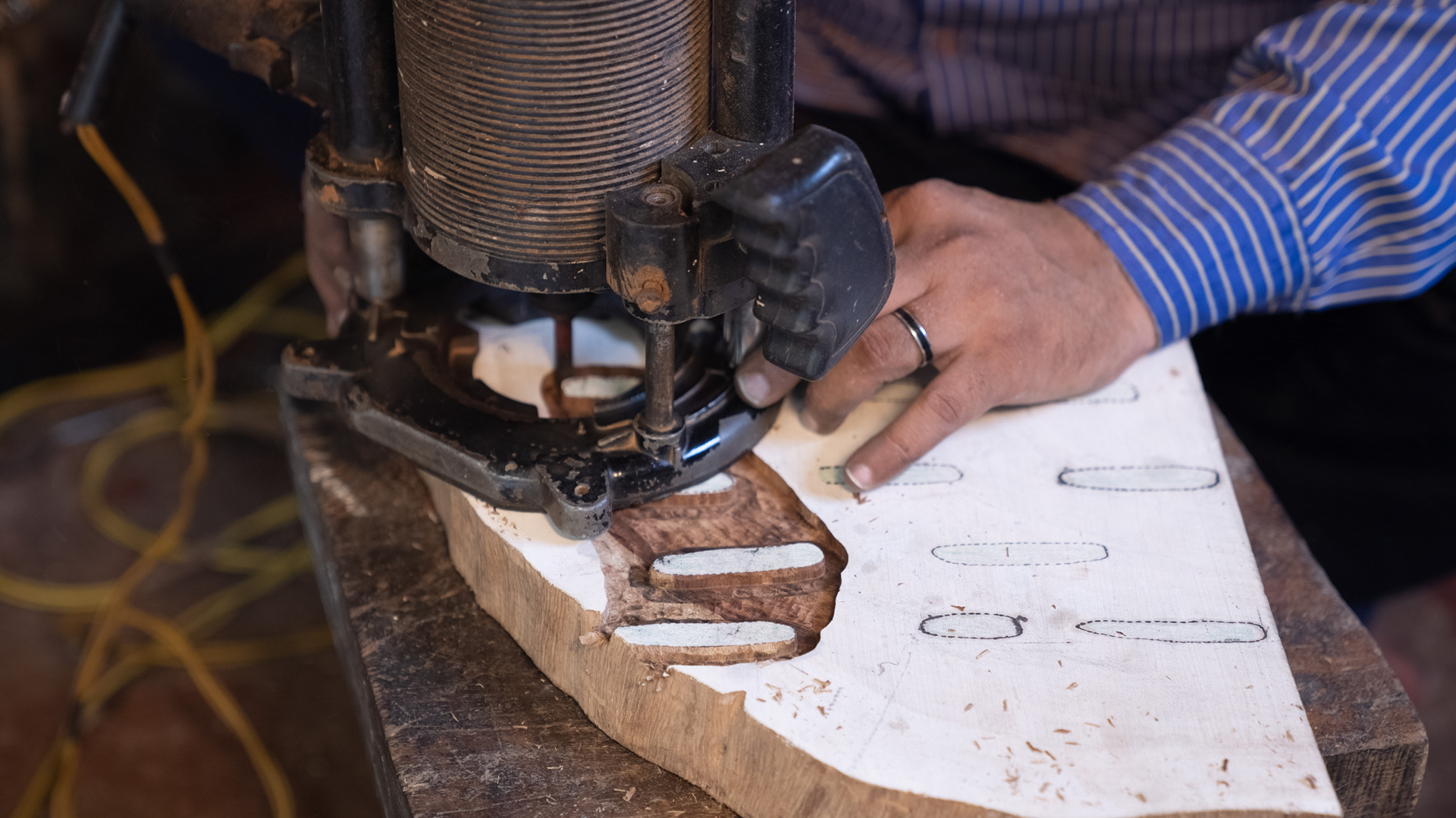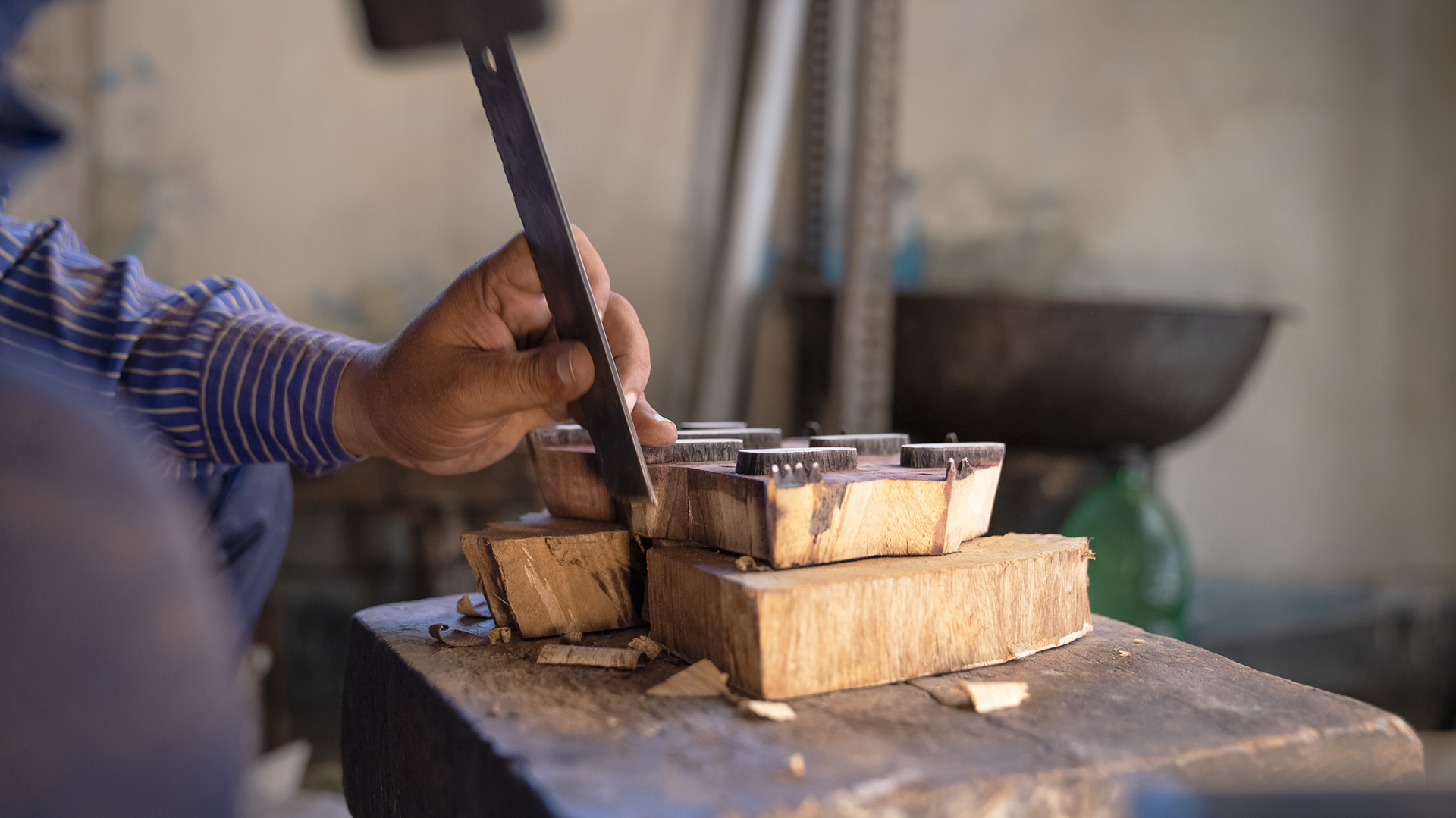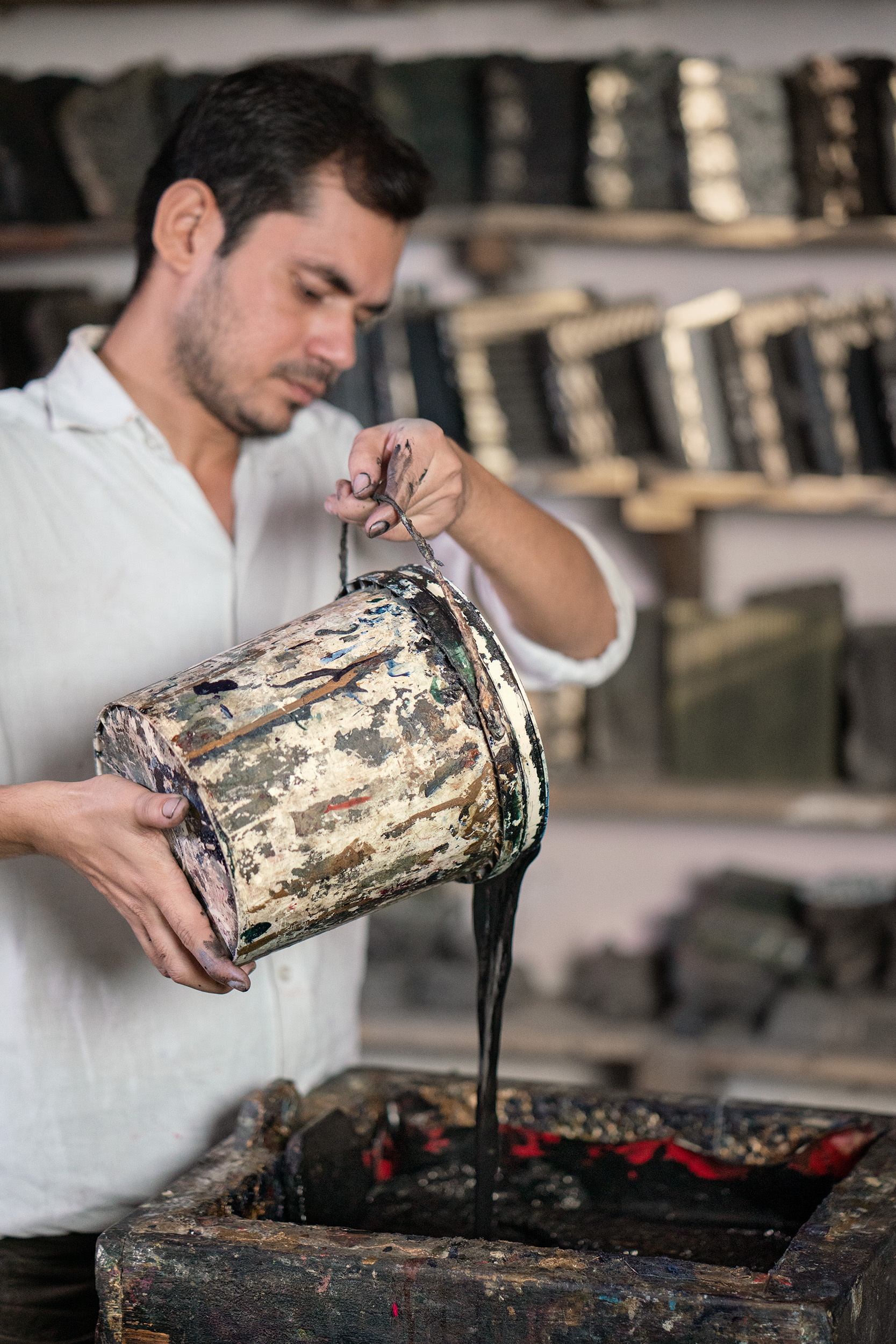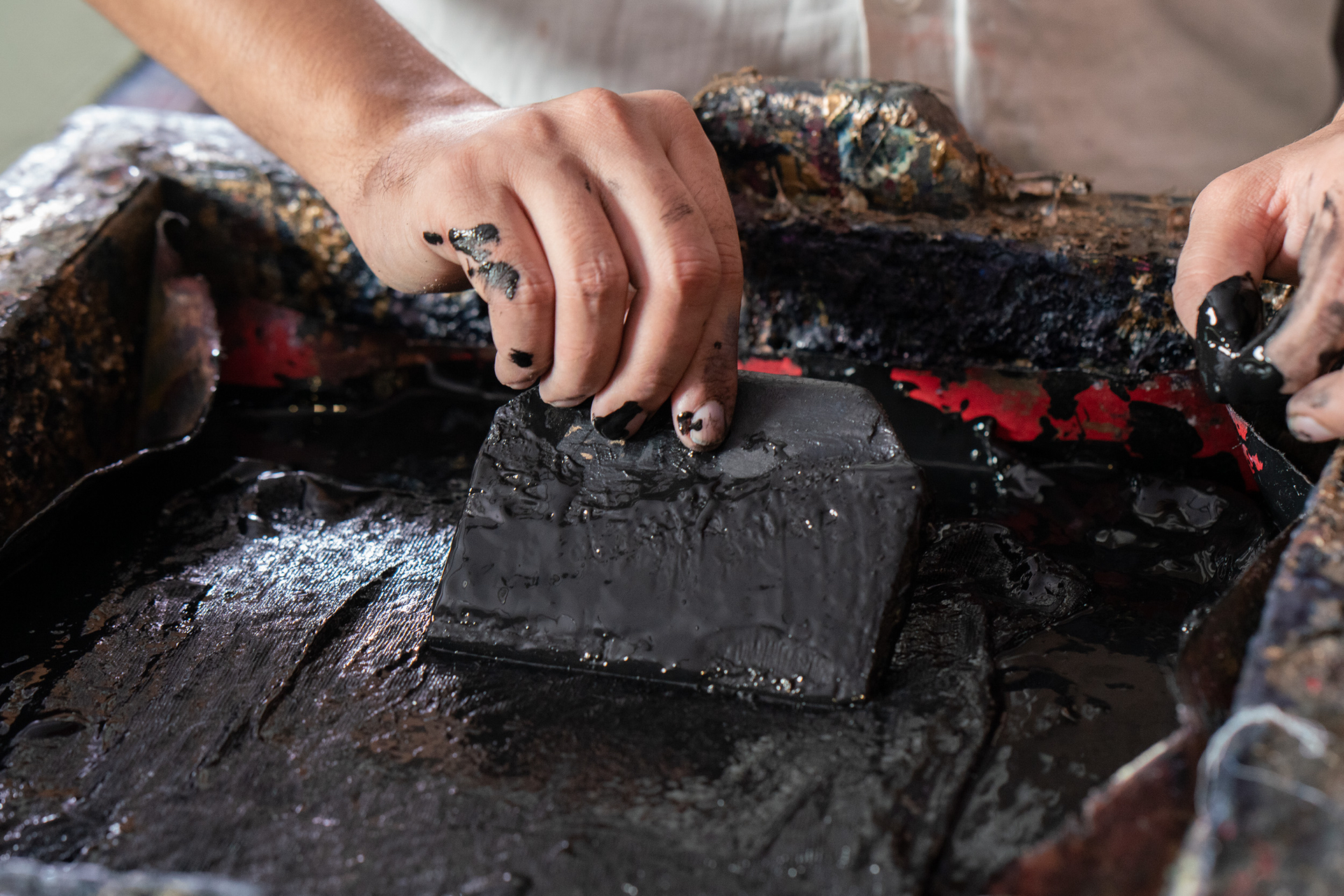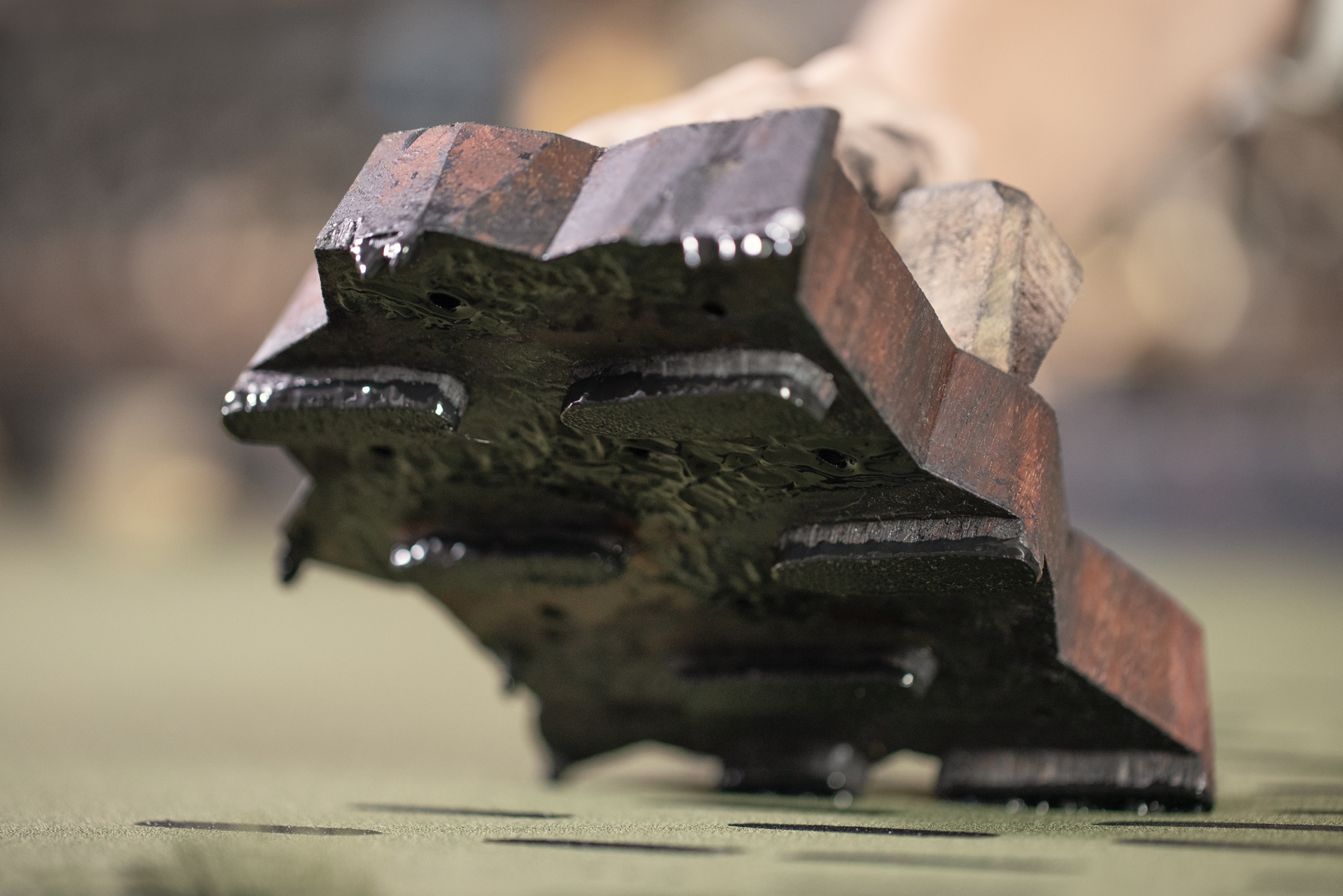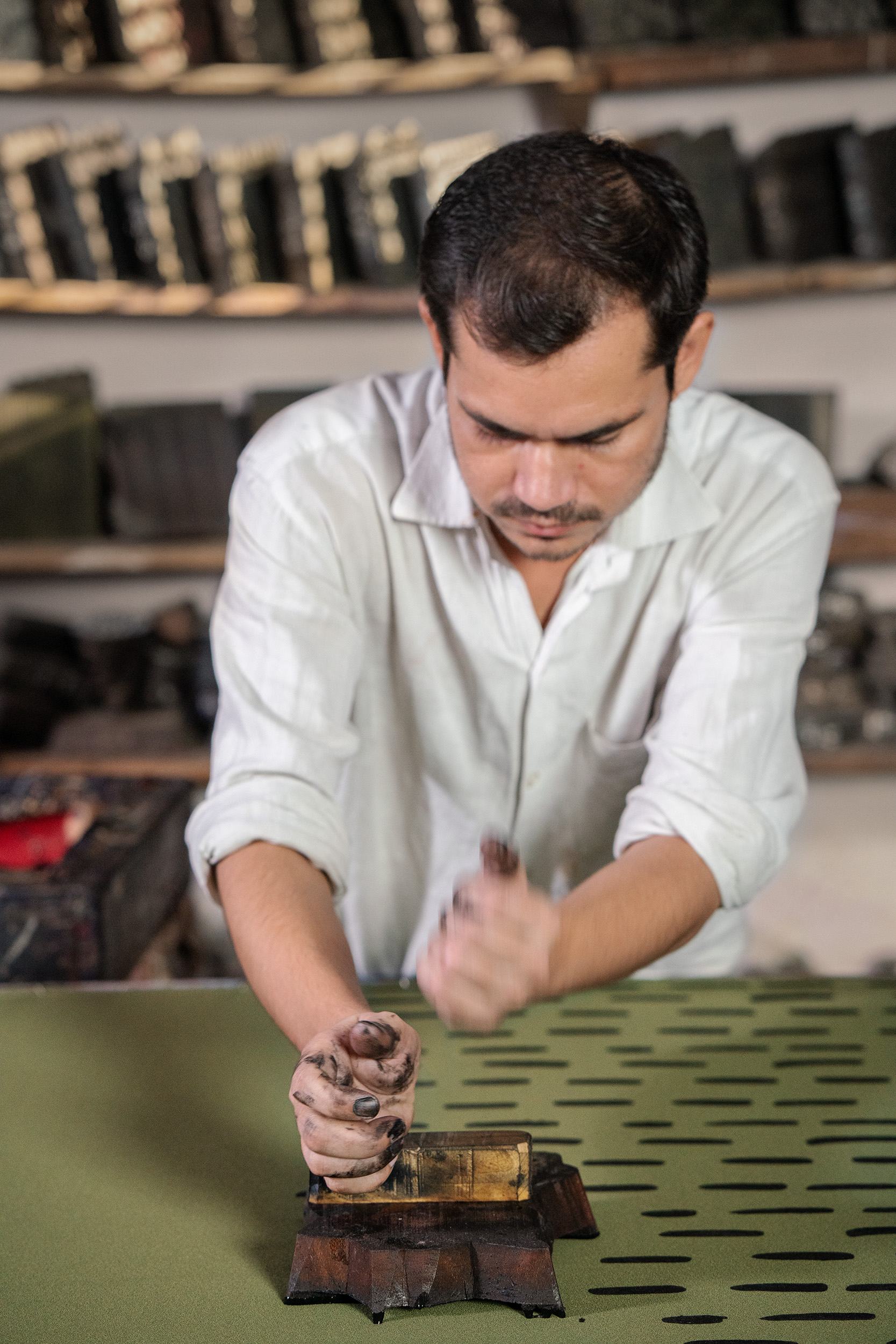Textiles decorated with hand-block printing have been synonymous with India for many centuries. The earliest evidence of this vibrant and rich tradition dates back to the ninth century BCE. (Printed cloth fragments originating in Gujarat were unearthed at a burial site in Fustat, Egypt.) The art of printing fabrics on the subcontinent, however, goes all the way back to the Indus Valley Civilization. Over the course of history, trade in these magnificent stamped fabrics made the Indian subcontinent a vital commercial hub for merchants and traders from around the world.
Indian craftsmen have perfected to the highest degree the art of block printing on a myriad of surfaces using wooden and metal blocks. The rhythmic, almost mechanical movements they make while printing the textiles is a result of deep knowledge and many years of training. The traditional practice of creating block-printed fabrics primarily uses carved wooden or metal blocks that are dipped in natural colour and then firmly pressed on cloth. The more intricate and colourful the pattern is, the more rounds of printing are required using different kinds of blocks.
These images illustrate the labour-intensive steps involved in creating block-printed garments. They reveal the symbiotic relationship between the block makers and the block printers. Each is dependent on the other’s knowledge and skill set in order to create these sublime, imprinted fabrics with intricate motifs and vivid colours. The final product, also seen here, is a perfect example of synthesis of traditional craft practices and modern sensibilities. Block printing is a viable technique that allows for constant adaptability. Designers Abraham & Thakore have created a garment using recycled sustainable fabric that has been block printed using conventional methods. Their new collection was inspired by the concept of “Assemble. Disassemble. Reassemble” and was created in collaboration with R-Elan, a fashion line by Reliance. This ready-to-wear collection represents A&T’s ethos of working with traditional yet sustainable handmade fabrics.
The process of creating hand-block printed textiles begins with the intricate carving of wooden blocks used for printing. Although wooden blocks are now more common, brass blocks were once favoured for intricate designs, as they offer a high level of clarity while printing. Brass blocks are also more durable than wooden ones. They are comparatively expensive, however, and time-consuming to make. Wooden blocks are typically made from teak or sheesham (rosewood), both preferred for their durability. Trained craftsmen prepare these blocks by taking a piece of wood and smoothing the surface with a grinding machine. This allows for the next step: tracing the intricate pattern onto the wood’s smooth surface. The block makers place the sheet of paper with the design onto the wooden piece. This serves as a map for the craftsman to trace the motif’s outlines by transferring the pattern onto the new surface by rubbing it with lampblack and oil.

Designs made for printing are usually geometric or consist of floral and animal motifs. Several fashion houses such as A&T are experimenting however with unconventional motifs and creating innovative patterns for the contemporary market. In one of the garments seen here, the inspiration for the printed design comes from the traditional kantha stitching technique, which along with appliqué has conventionally been used to recycle textile fragments. Adaptability and reuse are constantly kept in mind at every stage of the design and creation process.
After the design has been traced on wood, the artisan begins the task of carving, using steel chisels of different widths and cutting surfaces. The motif is carved on the base of the wooden block while a handle is attached at the top. Each block has two or more cylindrical holes drilled into it, which allows for air to pass through and enables the release of excess colour as well. Blocks made for printing are made in several sizes and shapes, including rectangular, square, oval, semicircular and circular – each used for different purposes. The lead blocks that create the outline patterns are known as rekh; the foreground or the filler block is called a data; and the block used for the background is called gadh. There are also examples of different pieces of blocks constructed in such a way that their grooves fit into another block, which are then joined together to form one solid block. A combination of these varying blocks is what creates the magnificent patterns and hues we see on running printed fabrics.
Once the blocks are ready, they are then soaked in oil for ten to fifteen days to soften the grains of the wood. This does not affect the strength of the wooden sheesham blocks, which can usually print up to two hundred metres of fabric. However, the high cost of this wood has forced many block makers to use substitute woods such as roheda and bhujan. Though cheaper, they are not as durable.
After the blocks are carved, the process transfers over to the printmaker. The process of printing textiles starts by washing the fabric chosen for printing. Traditionally a wide range of fabrics are favoured for printing, including cotton, silk, organza, jute, kota doriya, chiffon and even paper. Interestingly, the fabric seen in these images, however, is created by recycling post-consumer PET bottles. Approximately nine or ten bottles are recycled to make one metre of cloth.
Traditionally the fabric is first washed thoroughly to remove the starch and dipped in a solution of water and bleach for one or two days to soften it. It is then boiled and washed again. If the cloth is to be dyed, it is done at this stage and then washed again to remove the excess dye before the block printing process begins. After the cloth has been completely dried in the sun over several days, it is stretched over a large printing table. The table’s surface is usually covered with numerous layers of cloth, jute and canvas, which allows for good quality printing.
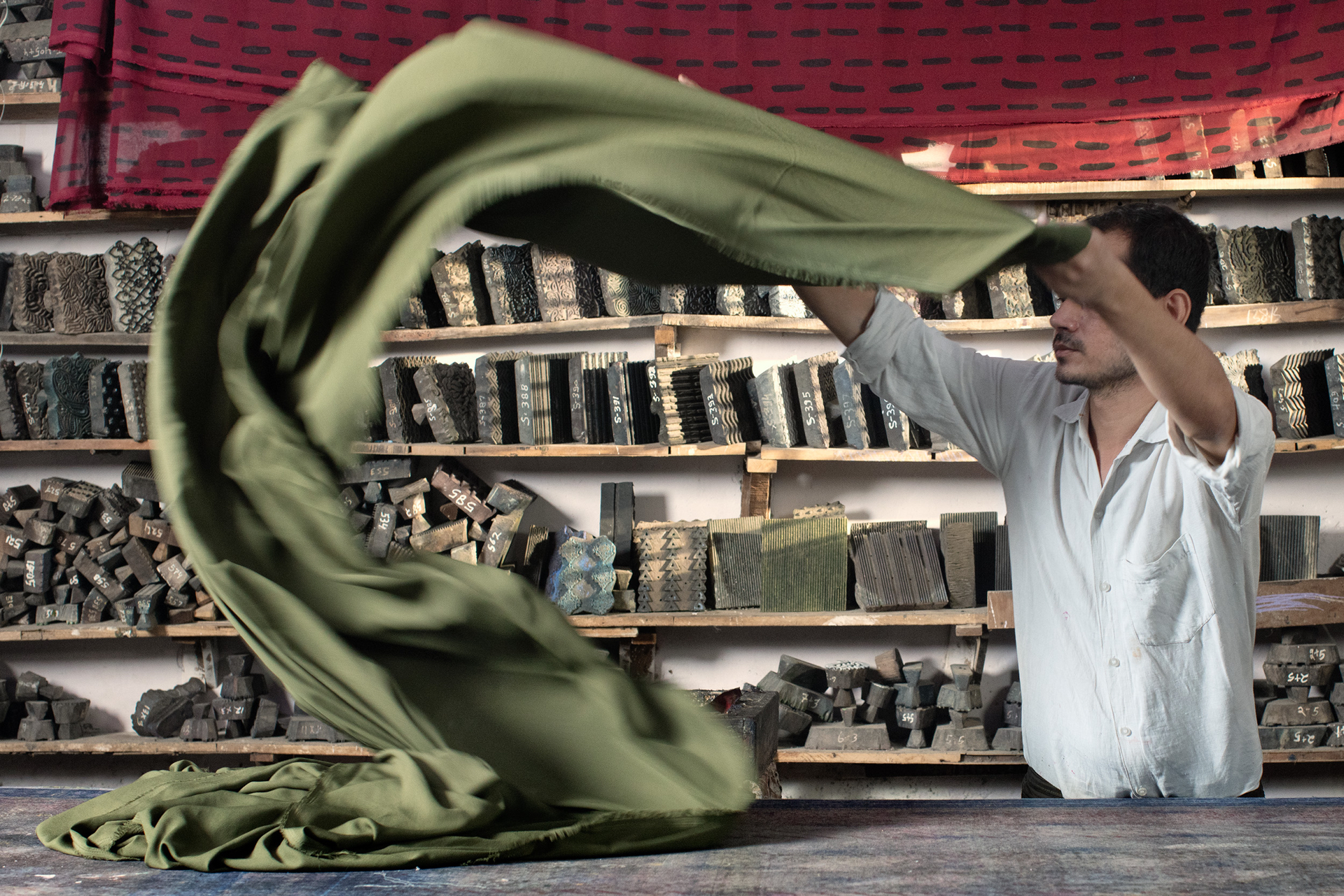
As seen in these images, the dyed fabric is spread across the printing table and secured all around with small pins. This is done to ensure that the cloth remains taut and that there are no loose portions forming ripples on the surface of the material. After the textile is ready, the craftsman uses a scale and chalk to mark the areas to be printed and appropriate gaps are left for cutting and stitching. At the same time, the printer also transfers the pre-made dye used for the printing from a bucket to a flat wooden tray. Many artisans who favour traditional techniques and materials prefer natural vegetable dyes. But in many quarters, synthetic, cheaper dyes are replacing conventional natural colours due to their easy availability. Once the colour has been poured into the tray, a wire mesh covered with felt is placed inside. The felt absorbs the colours, after which a fine cotton cloth, or mulmul cloth, is placed atop the felt. This enables the printer to apply the colours on the block more efficiently.
With everything in place, the printers begin their methodical artistry. The carved wooden block is gently dipped into the tray with the dye and then the process of imprinting the pattern on the cloth begins. The printing process is done left to right, and the printmaker must press the block with same level of pressure with every repeat pattern. This uniformity in practice ensures the intensity of the colours and the consistency of the design on the fabrics. Precision is key here, as the printer needs to create a repeat pattern in a symmetrical manner without using any tools or implements, just his eyesight and instinct. In Rajasthan this printing process is known as Chapaai – and in fact the community of artisans involved in practising this traditional technique are known as Chippas. While the printers are predominantly Hindu, the majority of the dyers and block makers are Muslim.
After the printing is finished, the cloth is washed once again to remove excess colours and then dried in the sun for several days. Only after the fabric is completely dry do the tailors begin to mark, create, and cut the silhouette on the imprinted fabric.
Historic vocations such as block making and block printing continue to be performed in several parts of India even today. The mastery of Indian craftspeople has enabled them to adapt to contemporary markets where innovative design ideas are constantly in demand among a growing base of urban consumers. In these images, we see a glimpse of how our traditional craft practices can engage newer audiences by adapting to their evolving tastes and needs. The finished garment seen here, coloured all over in earthy red with black patterns, is minimal and modern, yet entirely a product of age-old methods performed by generations of knowledgeable, skilled artisans.

